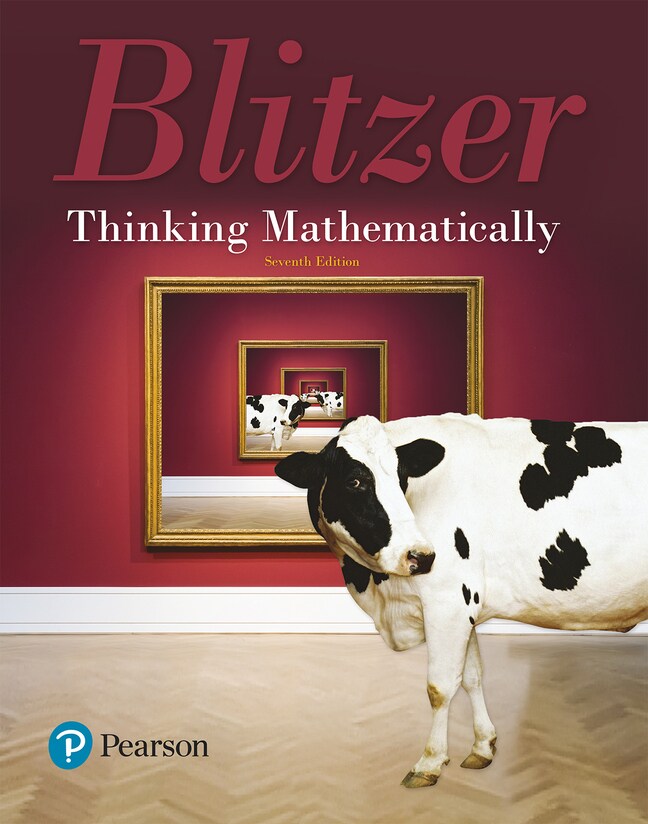
Thinking Mathematically, 7th edition
- Robert F. Blitzer

- Listen on the go
Learn how you like with full eTextbook audio
- Find it fast
Quickly navigate your eTextbook with search
- Stay organized
Access all your eTextbooks in one place
- Easily continue access
Keep learning with auto-renew
Thinking Mathematically helps you see the world around us as both mathematical and meaningful. In his distinctive, relatable voice, well-known author and educator Bob Blitzer demonstrates how truly relevant and fun math can be using current data compiled from hundreds of books, magazines and online sources. Compelling applications drawn from real life range from the value of online classes to modeling coronavirus cases to highest-paid celebrities. Understanding that most students in this course are not math majors, Blitzer focuses on student preparedness by incorporating learning aids and ample practice to support students entering the course at any level. The 7th Edition revises graphing calculator screens, updates and adds new applications throughout, and much more.
Published by Pearson (July 14th 2021) - Copyright © 2019
ISBN-13: 9780137502240
Subject: Liberal Arts Math
Category: Liberal Arts Math
- (NOTE: Each chapter concludes with a Chapter Summary, Review, and Test, and a comprehensive Chapter Test.)
- Problem Solving and Critical Thinking
- 1.1 Inductive and Deductive Reasoning
- 1.2 Estimation, Graphs, and Mathematical Models
- 1.3 Problem Solving
- Set Theory
- 2.1 Basic Set Concepts
- 2.2 Subsets
- 2.3 Venn Diagrams and Set Operations
- 2.4 Set Operations and Venn Diagrams with Three Sets
- 2.5 Survey Problems
- Logic
- 3.1 Statements, Negations, and Quantified Statements
- 3.2 Compound Statements and Connectives
- 3.3 Truth Tables for Negation, Conjunction, and Disjunction
- 3.4 Truth Tables for the Conditional and the Biconditional
- 3.5 Equivalent Statements and Variations of Conditional Statements
- 3.6 Negations of Conditional Statements and De Morgan’s Laws
- 3.7 Arguments and Truth Tables
- 3.8 Arguments and Euler Diagrams
- Number Representation and Calculation
- 4.1 Our Hindu-Arabic System and Early Positional Systems
- 4.2 Number Bases in Positional Systems
- 4.3 Computation in Positional Systems
- 4.4 Looking Back at Early Numeration Systems
- Number Theory and the Real Number System
- 5.1 Number Theory: Prime and Composite Numbers
- 5.2 The Integers; Order of Operations
- 5.3 The Rational Numbers
- 5.4 The Irrational Numbers
- 5.5 Real Numbers and Their Properties; Clock Addition
- 5.6 Exponents and Scientific Notation
- 5.7 Arithmetic and Geometric Sequences
- Algebra: Equations and Inequalities
- 6.1 Algebraic Expressions and Formulas
- 6.2 Linear Equations in One Variable and Proportions
- 6.3 Applications of Linear Equations
- 6.4 Linear Inequalities in One Variable
- 6.5 Quadratic Equations
- Algebra: Graphs, Functions, and Linear Systems
- 7.1 Graphing and Functions
- 7.2 Linear Functions and Their Graphs
- 7.3 Systems of Linear Equations in Two Variables
- 7.4 Linear Inequalities in Two Variables
- 7.5 Linear Programming
- 7.6 Modeling Data: Exponential, Logarithmic, and Quadratic Functions
- Personal Finance
- 8.1 Percent, Sales Tax, and Discounts
- 8.2 Income Tax
- 8.3 Simple Interest
- 8.4 Compound Interest
- 8.5 Annuities, Methods of Saving, and Investments
- 8.6 Cars
- 8.7 The Cost of Home Ownership
- 8.8 Credit Cards
- Measurement
- 9.1 Measuring Length; The Metric System
- 9.2 Measuring Area and Volume
- 9.3 Measuring Weight and Temperature
- Geometry
- 10.1 Points, Lines, Planes, and Angles
- 10.2 Triangles
- 10.3 Polygons, Perimeter, and Tessellations
- 10.4 Area and Circumference
- 10.5 Volume and Surface Area
- 10.6 Right Triangle Trigonometry
- 10.7 Beyond Euclidean Geometry
- Counting Methods and Probability Theory
- 11.1 The Fundamental Counting Principle
- 11.2 Permutations
- 11.3 Combinations
- 11.4 Fundamentals of Probability
- 11.5 Probability with the Fundamental Counting Principle, Permutations, and Combinations
- 11.6 Events Involving Not and Or; Odds
- 11.7 Events Involving And; Conditional Probability
- 11.8 Expected Value
- Statistics
- 12.1 Sampling, Frequency Distributions, and Graphs
- 12.2 Measures of Central Tendency
- 12.3 Measures of Dispersion
- 12.4 The Normal Distribution
- 12.5 Problem Solving with the Normal Distribution
- 12.6 Scatter Plots, Correlation, and Regression Lines
- Voting and Apportionment
- 13.1 Voting Methods
- 13.2 Flaws of Voting Methods
- 13.3 Apportionment Methods
- 13.4 Flaws of Apportionment Methods
- Graph Theory
- 14.1 Graphs, Paths, and Circuits
- 14.2 Euler Paths and Euler Circuits
- 14.3 Hamilton Paths and Hamilton Circuits
- 14.4 Trees
- Answers to Selected Exercises
- Credits
- Subject Index